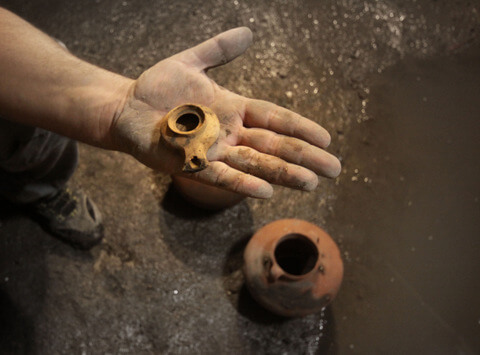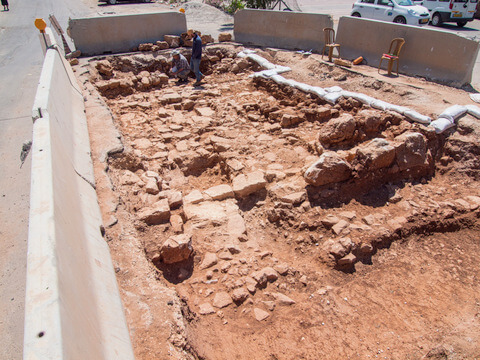In an archaeological dig by the Antiquities Authority near the Western Wall in the drainage channel that goes from the Shiloh Pool in the City of David to the Robinson Arch in the Jerusalem Archaeological Garden, three complete cooking pots and a small clay candle were uncovered in a small water cistern

In the archaeological excavation conducted by the Antiquities Authority near the Western Wall in the Robinson Arch area of the Jerusalem Archaeological Garden, a small cistern belonging to the building was recently uncovered. Inside the pit were found three innocent cooking pots, as well as a small clay candle, dating from the time of the Great Rebellion.
The vessels were found inside the drainage channel that was fully exposed from the Shiloh Pool in the City of David to the bottom of the Robinson Arch.
According to Eli Shukron, the director of the excavation on behalf of the Antiquities Authority, "This is the first time that it is possible to link the archaeological find to the issue of famine in Jerusalem during the siege rebellion. The intact cooking pots and the clay candle testify that people went down into the pit and ate the food there secretly, without anyone being able to see them - as Joseph ben Matityahu said."
In his book "The History of the War of the Jews in the Romans" Joseph ben Matityahu describes the Roman siege of Jerusalem, and in its aftermath - the severe famine that prevailed in the besieged city. In his dramatic description, he tells of the Jewish rebels, looking for food in the homes of their fellow Jews in Jerusalem. These, according to Ben Matityahu, hid the food they had in their possession for fear of looting by the rebels, and ate it in hidden places in their homes.
"The insanity of the rebels intensified at the same time as the hunger.... When no grain was found (according to) the multitudes, the rebels broke into the houses and conducted a thorough search, if they found (anything) they abused (the residents) for denying its presence, and if they found nothing, they tortured them with their eyes on who hid him so successfully..."
"Many converted their possessions in one place, the rich (in Iphat) into wheat and the poor (in Iphat) into barley, and then shut themselves up in the most hidden corners of their houses. Some of them devoured the percentages of gluttony and the kernels of grain as they were, they would donate them as much as they allowed them in the time of stress and fear. In no house is a table set..."
(Yosef ben Matityahu, The History of the Jewish War in the Romans, 924:928-XNUMX, translated by Lisa Ullman)

Greetings from the Roman Empire: a 1800-year-old road section was uncovered in Jerusalem (June 2013)
According to the director of the excavation on behalf of the Antiquities Authority, "This is the first time we have come across such a state of preservation of the road within the borders of Jerusalem" *The road was uncovered as part of an archaeological dig by the Antiquities Authority before the laying of a drainage pipe by the Moriah company
An ancient road from the Roman period (4nd-2th century AD), which led from Jaffa to Jerusalem, was uncovered during the last two weeks in the Beit Hanina neighborhood in northern Jerusalem. This, as part of an archaeological excavation by the Antiquities Authority in the neighborhood, before the laying of a drainage pipe by the Moriah company.
The wide road (about 8 meters), was bordered on both sides by curb stones. It itself consists of large, flat stones that have been adjusted to each other, in order to create a comfortable surface for walking.
Some of the stones are very worn, and show that the road has been used a lot, and it has even undergone a series of repairs over the years.
According to David Yager, the director of the excavation on behalf of the Antiquities Authority, "several sections of the road were excavated in the past by research delegations of the Antiquities Authority, but such preservation of the road has not been discovered so far within the boundaries of the city of Jerusalem. The Romans attached great importance to the roads in the empire. They invested the best of their money and mobilized the best technological aids of the time in order to inherit the empire in roads. These served the administration, the army, the economy and the public for an efficient and safe transition. Stations and road inns were built along the roads, as well as fortresses to protect passers-by. The paving and maintenance of the roads were assigned to the army units, but the citizens also participated in the works as part of the mandatory work imposed on them by the authorities.
The section of road discovered in the excavations of the Antiquities Authority in Beit Hanina is part of an imperial road system that led to Jerusalem from the coastal plain. These roads are known both from historical sources and from archaeological excavations. In the Roman period, two main roads led from Jerusalem to Jaffa: one through Beit Horon and the other through Shaar HaGai. The road before us is a section of the road to Jerusalem that passes through Beit Horon. The route of this road started in Jaffa and passed through the city of Lod where the road split into two different directions: one towards Shaar HaGai and the other through Modi'in along the route of today's Highway 443 to Beit Horon from where the road continued east to Bir Nabala and turned south to Kfar Shaul where it joined the road to the mountain ridge that led to the city the ancient
The movement of the temple lamp
What trees did the Romans use in the siege of Masada?
The shocking story of Mariah daughter of Elazar
The priesthood as you did not know XNUMX - a total mess in Jerusalem
The priesthood as you did not know it XNUMX - the great rebellion and the priesthood
